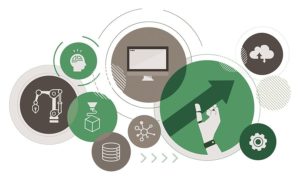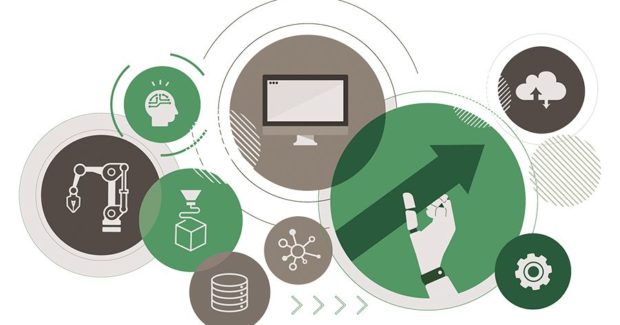Funding Your Company’s Digital Transformation
To realize the full potential of implementing digital initiatives within your operation, consider what type of impact these initiatives can have, and how you can monetize the changes. In some cases, the monetization is simply reducing costs.
Posted: February 22, 2022
PROFIT MASTERY
Going digital is all the rage right now. In fact, when you do a Google search for “digital manufacturing in the fabrication industry” you receive nearly 64.2 million results! (When you search for “digital manufacturing” you receive 800 million results!)
That’s a lot of information. But how does one make sense of it all? This article explains a bit about the options for digital transformation, what it can mean for a manufacturing or fabricating company, and how you can obtain funding for the implementation of digital initiatives.
Digital Transformation Defined
The term “digital transformation” has been used in various capacities in the manufacturing and fabrication industry for a while now. Going back to the 1990s with the introduction of email and websites, “digital” has meant many things to many people, but the term encompasses everything from social media to Big Data, to networked (connected devices), to ERP systems and more. In fact, Gartner Research, in a recent survey of Chief Information Officers, identified the top six technology investment categories as:
- Cyber/Information Security
- Business Intelligence/Data Analytics
- Cloud Services/Solutions
- Internet of Things
- Process Automation
- Artificial Intelligence/Machine Learning
 The first three of these refer more to data information, security and storage and have greater applications for the IT (information technology) and/or BI (business intelligence) departments. The last three of these have greater implications for the manufacturing or production teams.
The first three of these refer more to data information, security and storage and have greater applications for the IT (information technology) and/or BI (business intelligence) departments. The last three of these have greater implications for the manufacturing or production teams.
Tim Vaughn of communications company Poppulo, defines digital transformation as “the process of utilizing modern technology to create new — or modify existing — business processes, culture and customer experiences.” He further classifies digital transformation into four main categories:
- Process transformation — Adding digital capabilities to existing internal processes (ERP systems, connected production devices/equipment, etc.).
- Business model transformation — Example: Netflix moving from mailed DVDs to on-demand viewing.
- Domain transformation – Example: Amazon adding cloud computing/infrastructure services to its existing product distribution services.
- Cultural/organizational transformation – Internally embracing, adopting and advancing technology.
For most manufacturing companies looking to begin digital initiatives, categories one and four are most relevant.
Digital Manufacturing
For the purposes of this article, specifically as it relates to the manufacturing and fabrication industry, we’ll refer to TWI Global’s definition of digital manufacturing “the application of computer systems to manufacturing services, supply chains, products and processes. Digital manufacturing technologies link systems and processes across all areas of production to create an integrated approach to manufacturing, from design to production and on to the servicing of the final products.”
You’ve probably heard the terms “smart factory,” “Industrial Internet of Things (IIoT),” or “Industry 4.0.” These are all terms that refer to interconnected, computer networked manufacturing equipment.
Does Digital Manufacturing Make Sense for Your Business?
Absolutely. Here’s a hard fact: If you haven’t already begun implementing some form of digital technology into your manufacturing business, you are seriously behind the curve. Not all digital initiatives are exceptionally expensive and most, especially if implemented well, can have a significant positive return on investment (ROI).
The key is to determine where digital initiatives can be implemented, what type of impact they can have, and how a company can monetize the changes. In some cases, the monetization is simply reducing costs (which could include reducing scrap, increasing throughput, and generally enhancing productivity).
Components of Digital Manufacturing Implementation
There are four main components to a digital manufacturing implementation:
- Software
- Hardware
- Integration/Installation/Implementation
- Training
In some cases, there may not be additional hardware, but by the sheer nature of digital, there will almost always be a software component. When considering pricing for digital initiatives, you need to add in the costs for integration/installation/implementation and training.
Rob Caron, president of Caron Engineering, a company that specializes in smart manufacturing solutions, noted that the costs for integration/installation/implementation and training can be expensive and time consuming but are critical to the success of the initiative. He further noted that costs have been coming down in recent years (pandemic factors notwithstanding).
Paying for the Digital Transformation
When evaluating costs for a digital implementation, hardware is mostly considered a “hard cost” and typically involves an asset purchase — examples include a networkable machine, a robot, or other piece of capital equipment. These hard costs are not difficult to finance because they are a form of collateral against which a UCC (Uniform Commercial Code) lien can be filed.
The “soft costs,” i.e., software, installation/integration services, and training, are much more difficult to finance. Depending on the initiative, soft costs can account for an extremely large portion of the total cost. There are some specialized lenders that will finance software, and some will even finance the implementation and training costs, but because the items being financed are typically unsecured, interest rates can be significantly high.
In some cases, depending on the value of the hardware and the costs of the required software and services, the soft costs can be financed along with the hardware. In these cases, the value of the hardware or equipment must provide for enough equity to ensure the lender has a strong enough collateral position to cover the soft costs.
An alternative funding method is to leverage the equity in your existing manufacturing and fabricating equipment. This involves refinancing existing equipment to obtain a cash out (working capital) loan. The proceeds from that loan can then be used to pay for the digital investment, including the soft costs. To do this, the equipment being refinanced must either be paid for free and clear, or paid down to the point where there is enough equity to allow for a cash out loan.
Start Small
Costs and timing for digital initiatives vary widely. ERP implementations can take more than a year and cost hundreds of thousands of dollars. But adding some automation software to existing equipment to help with predictive processes can cost less than $25,000.
To begin your digital transformation, you need to understand your business operations and goals. Determine the current situation, where your processes or systems need improvement, then define how a digital initiative can help with that improvement. Find a partner or vendor that can help you assess your needs and provide the type of digital solution needed. Your digital partner/vendor can help you evaluate your options.
Caron’s advice regarding a digital initiative is to start small, if possible. This helps mitigate risk and initial investment. If the hardware/software can be installed on one or two machines initially, do that. Implement the program, monitor the results, and determine the ROI. If, as in many cases, the ROI is positive, build the business case for additional investment and implementation.
Digital investments can start small and expand in size and scope. Keeping them manageable and measurable will help your business gain knowledge and understand the benefits. This can help you prioritize the various digital investments, thus helping ensure your continued growth and competitiveness in the marketplace.













